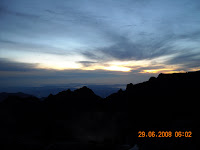Water fall at
Mt. Santubong

Part of
the jungle trail

View from
Mt. Santubong
Summit
Posted by jasweiq at 7:53 PM 0 comments
Labels: Mt. Santubong
 The Biadak water fall is situated near the village
The Biadak water fall is situated near the village
called Kampung Braang Bidak at Padawan area
about 45 mins away from Kuching city.
The jungle trail to the water fall is not that
rough and you easily can get there by 25 mins
from the Kampung Braang Bidak.
Before you can explore to the water fall area,
it wise the you get the permission from the
Ketua Kampung as you know that this water
fall is their daily water source & gravited use pipes to the kampung.
Bidak water fall
before
the downpour
Bidak water fall
begining of
the down pour
Bidak water fall
during the
down pour
Bidak water fall
after the
down pour
Posted by jasweiq at 7:56 PM 0 comments
Labels: Bidak Water Fall
Ban Kukut waterfall
Posted by jasweiq at 8:08 PM 0 comments
Labels: Ban Kukut Water Fall
The Iban
The Ibans are a branch of the Dayak peoples of Borneo.They were formerly known during the colonial period by the British as Sea Dayaks. Ibans were renowned for practising headhunting and tribal/territorial expansion. A long time ago, being a very strong and successful warring tribe, the Ibans were a very feared tribe in Borneo. They speak the Iban language.
Today, the days of headhunting and piracy are long gone and in has come the modern era of globalization and technoloy for the Ibans. The Iban population is concentrated in Sarawak, Brunei, in the West Kalimantan region of Indonesia. They live in longhouses called rumah panjai. Most of the Iban longhouses are equipped with modern facilities such as electricity and water supply and other facilities such as (tar sealed) roads, telephone lines and the internet. Younger Ibans are mostly found in urban areas and visit their hometowns during the holidays. The Ibans today are becoming increasingly urbanised while (surprisingly) retaining most of their traditional heritage and culture.
Heritage:Musical & Dancing
The Iban have a musical heritage consisting of various types such as tawak , engkerumungs, bendai and also a set of ketebung The Iban also play an instrument. One example of Iban traditional music is the taboh.The Ibans perform a unique dance called the ngajat. It serves many purposes depending on the occasion. During Gawais, it is used to entertain the people who in the olden days enjoy graceful ngajats as a form of entertainment. Iban men and women have different styles of ngajat. The ngajat involves a lot of precise body-turning movements. The ngajat for men is more aggressive and depicts a man going to war. The women's form of ngajat consists of soft, graceful movements with very precise body turns. Each ngajat is accompanied by the taboh.
Branches of the Iban People
Although Ibans generally speak a dialect which is mutually intelligible, they can be divided into different branches which are named after the geographical areas where they reside.
Majority of Ibans who live around the Lundu and Samarahan region are called Sebuyaus.
Ibans who settled in areas in Serian district places like Kampung Lebor, Kampung Tanah Mawang are called Remuns.
Ibans who originated from Sri Aman area are called Balaus.
Ibans who come from Betong, Saratok, Roban & parts of Sarikei are called Saribas.
The Lubok Antu Ibans are classed by anthropologist as Ulu Ai Ibans.
Ibans from Undup are called Undup Ibans. Their dialect is somewhat a cross between the Ulu Ai dialect & the Balau dialect.
Ibans living in areas from Sarikei to Miri are called Rajang Ibans. They are the majority group of the Iban people. They can be found along the Rajang River, Sibu, Kapit, Belaga, Kanowit, Song, Sarikei, Bintangor, Bintulu and Miri. Their dialect is somewhat similar to the Ulu Ai dialect.
In Kalimantan, Iban people are even more diverse. The Kantu, Air Tabun, Semberuang, Sebaru' , Bugau, Mualang & along with many other groups are classed as "Ibanic people" by anthropologist. They can be related to the Iban either by the dialect they speak or their custom, ritual & their way of life.
Posted by jasweiq at 6:49 PM 0 comments
Bario.
Perhaps it was the exotic ring
of its name, perhaps just wanderlust,
which took me to this seldom
travelled corner of Sarawak
State in Borneo.
Mountains that can be seen when
ones' fly from Miri to Bario
Sunset at Bario
Twin Otter
Posted by jasweiq at 8:17 PM 1 comments
Mr. Cr. Hillary Jamba
ngulu ka bala Yb. Jelaing
leboh "opening Ceremony"
rumah panjai Metong
Sekeda ari photo
ke bisi diambi
leboh maia
"opening Ceremony"
rumah panjai Metong
Mandal tuai rumah
Mr. Sabi
enggau nembiak sida iya
maia ngelalu
Ke penatai Yb. Jelaing
Sekeda ari WI
ke bisi Ngelalu
ke peniki Yb. Jelaing
Tk Mr. Ramping ak Manan
nyua ke 'Memento' ngagai
Yb. Jelaing maia 'opening
ceremony' rumah pangai
di Metong, Roban
Posted by jasweiq at 6:22 PM 0 comments
Labels: Metong Roban opening ceremony
Mt.Kinabalu
(Laban Rata)
Myself &
a friend
at Mt. Kinabalu
SUNRISE
at Mt. Kinabalu
On the way down
from Mt. Kinabalu
Posted by jasweiq at 8:16 PM 0 comments